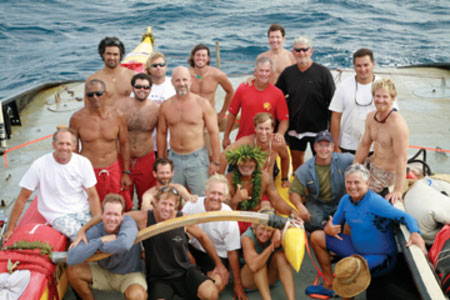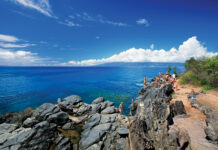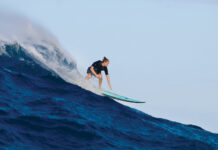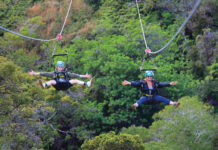 SUNDAY, AUGUST 6th 2006
SUNDAY, AUGUST 6th 2006
Jamie Woodburn:
2:00 p.m. Finally, we’re underway, almost hard to believe. The pre-voyage preparation this year seemed to drain those of us closest to the effort of the rush felt with the prior voyages. Yet, at the same time, the stress of it all seemed to bring us all closer together. At times, I’m sure we all questioned if we’d get to this point. The farewells were brief, but delayed as we waited anxiously for Kimokeo and Ryn to arrive. Like new dogs in town, we scoped out the tug’s bunk spaces, galley and accommodations.
With the completion of our race at States, all thoughts and energy were focused on the voyage. Thinking back, the uplift I felt on Friday 8/4 when Moani informed me our permit had been granted, was so intense that I had to pull my truck off the road and take a few deep breaths. For me, it was a huge moment. Finally, the elephant was eaten and we could move forward to experience the majesty of the North West Hawaiian Islands.
Post departure waters immediately tested the resolve of us all and caused most to seek horizontal surfaces.
Even as I write this, I’m brought to tears at the relief and realization that we overcame what at times felt like insurmountable odds and did it. Good for us, and good for all that follow.
Matt Muirhead:
2:30 p.m. Saw Nihoa from starboard side, could see the majestic cathedrals—they looked dark and imposing. Still 25 miles out. Spotted a number of Tern birds dive-bombing at mach speeds. Waves are eastern with a little north—again, it is odd to be going 9 knots in waters we paddled two-years ago. Such a big ocean, the sets are running 8-10 ft. with clean faces and froths. It really means something to have traveled these waters. In a way it connects you and makes you feel different, reminding you that each journey is different and cannot be matched – only compared and given perspective.
MONDAY, AUGUST 7th 2006
George Rixey:
9:00 a.m. Moku Mana Mana
Necker Island
Boobies fly out to the NE from 200 miles out. Seas 4-8 ft., wind chop 1-2 ft. Trade oriented.
Kimokeo leads our way. We prepare to bless the wa‘a [canoe]. Each of the crew of 8 face each other as we chant E Ala E. From our belly center, we bring our mana out full, free, open and strong. Kava is passed to each paddler for blessing in our bodies, asking for strength and wisdom. Kimokeo blesses the wa‘a and the support vessels, the Trailership and Zodiac. The wa‘a is blessed with care and respect. Then we pray together crossing our arms over shoulders as Kimokeo blesses each one of us, sprinkling kava onto our heads, our shoulders. He blesses my left shoulder, which happened to be dislocated four months ago.
I have been asked to “stroke,” which is to set the pace, feel the movement of the wa‘a as she glides with the ocean. Also, I have been asked to steer and be “kapena,” the captain, of the canoe, after Kimokeo steers first, then Mike Spalding. This is a great honor for me; to be anywhere in the canoe is a blessing. To steer is a great responsibility I hold close to my heart and soul. To my heart in caring for the others, in my soul as a part of my whole being.
We spot dolphins on our port–south side— during the blessing.
WE SEE MOKU MANA MANA
9:30 a.m. 15 miles out. A small rock cloud on the horizon.
First we will meet MOKU MANA MANA.
Then KANE NI LOHA‘ I–“Tern Island” the most NW island of the “French Frigate Shoals.” We will pass from the North.
Then PUHA HONU–“Gardner Pinnacles,” the great bank.
Then KO‘ ANAKO‘ A–“Maro Reef,” the largest reef in the chain.
Then KAUO–“Laysan Island.”
The water is a beautiful, fresh blue. The surge of swell is evident in the push of the wa‘a. There is an underlying movement to the sea in our direction. You can feel the bite of the paddle blade as it pitches the wa‘a into a glide. There are moments when the blade is completely free above the water on the downward motion because the front of the canoe is completely out of the water. This is at the crest of a wave as it passes us by from underneath. On the face of the wave, all six paddlers can get a good, strong, short thrust which propels us forward with a surging speed. On the back of the wave, the paddles bite in deep and long, pushing backward a heavy mass of water. The wa‘a is traveling at about 6-7 mph, but the swell is running more like 10-12 mph. There is a cadence and rhythm to the paddling of the wa‘a as she matches the flow of the sea. Chris Luedi starts to chant I Ku Mau Mau and we all come together with a love and purpose, our voices mesh with the flow. We have a very long voyage ahead of us. The key is stay conscious, calm, and steady.
As the sun sets and the stars come out, a great sky dome map appears over our heads. The North Star is clear about 15 degrees above the horizon and approximately 70 degrees to the north of the bearing of the canoe.
The night sky is stunningly beautiful. No artificial light from the Earth’s surface. Only the sun brilliantly lighting up the planets and the moon and the shining light of the stars. The seas have calmed down quite a bit with mostly just a peaky trade swell and only a slight chop. The moon appears huge as the clouds pass in front of it. It seems as though the lights get turned off and on as the moon pops in and out of view. As the moon gets ready to set, there is an awesome light glow emanating from the NE. It is the sun getting ready to appear as our planet Earth rotates eastward.
TUESDAY, AUGUST 8th 2006
Matt Muirhead:
We moved all our ‘ohana into a 40’ canoe—each paddler bringing a history and a purpose; exposing the inner-self—everything broken down—just the core. Our canoe is now our community. We live and travel in it.
Jamie Woodburn:
9:00 p.m. A cold night. We all found the ship’s “hotspots,” places where heat vents, while we waited for our rotations. I find the night rotations, often midnight, the hardest, especially when it’s raining.
The moon helped a lot, lighting up everything. Our escorts, boobies and petrels, stayed with us all night. The terns talked to us, while the boobies flew low over the waves and just skimmed above our heads. I wonder what they think of all this.
We saw several shooting stars, all of them moving north to south and parallel to the ocean surface. Jeff, Kimokeo, and I saw what looked like a dud of an aerial firework at about 2:00 a.m. to the NW. Flare? Shooting star? Don’t know if it was a flare, but we did report it to the Coast Guard and Jeff spoke with them. It could have been a shooting star coming from the distant horizon. Our heading is 288 from Gardner Pinnacles, ETA is about 2-3 a.m. We’re talking about taking a 4-6 hour break when we reach Gardner Pinnacles. We’ll load up the canoe, sleep, re-load and take off again. That should be about our mid-point and leave approximately 200 miles to Laysan.
Michael Spalding:
Winds are up. We reach Gardner Pinnacles in 20 hours. The waves are bigger as squalls move in, packing gusty winds before the fronts hit us. The canoe will come out to give everyone a break for 6 hours. At 10:00 p.m., the call is to pull the wa‘a out. The weather looks like it is turning for the worst, but it is a system that is pushing air and large waves at us. The plan is to bring the canoe on deck. First, we transfer out 6 and put in a fresh crew. After the transfer is made, a rope is attached to the nose of the wa‘a. The there is a heated conversation on what to do next with a lot of chiefs making big plans. I am running the zodiac and pick up the hook that will pull the wa‘a up on to the tug. There was a lot of barking and shouting. Matt was clear thinking and we followed his plan, which worked. Kimokeo and Chris stayed on the wa‘a. They had to swim to the zodiac after it was loaded. The winds were up to 15-25 knots and the waves were 5-12 ft. It was hairy and it took all of us to do the operation. The only way we were successful was because Akua [a divine or supernatural being] was watching over us.
Terry Quisenberry:
12 p.m. We have been paddling steadily for two days I think. We all need a break. We just loaded the canoe and zodiac on the escort. The escort was rolling to the swell while the canoe was bouncing to the chop, seas were lively and the fate of the voyage hinged on a safe and careful loading of the canoe and zodiac. I think Kanaloa did it for us since despite the rough seas, and need for split second timing, the canoe slid on like slipping your foot into an old comfortable slipper, very exciting. Once everything was safe, a rain blessing with giant drops that felt like they were a half ounce each hit us hard, just for a few seconds; they were as big as I have ever experienced. We were watched over and that rain was a reminder. Hot bath, food, and sleep, in that order.
WEDNESDAY, AUGUST 9th 2006
Michael Spalding:
At 6:00 a.m. Kimokeo wakes me and Gardner Pinnacle is in sight. We have a sunrise ceremony which includes chanting, blowing of the pu shell and presenting 4 pohaku for the islands we passed, as well as the Gardner Pinnacle. We place the wa‘a in the water and a monk seal greets us as we blow the pu. At that moment, about one thousand Noio birds fill the air in flight. The canoe is well balanced and flows in the swell. We are not catching waves, but getting a gentle push, which is easy to move on with a predominately windward helm. Steersmen are poking on the left to stay with the bump. There are three swells. Sometimes the south will pop up the ama, which gives us all a fright.
We are accompanied by various birds, which are talking to us. Jamie talks back to them and we feel like they are our protectors and guiding us on our journey.
Terry Quisenberry:
We’re now at Gardner Pinnacles. It’s a rock. It looks like Mount Fuji only much smaller and completely white at the tops; in this case, it’s bird guano, not snow. It’s a hump alive with birds all sizes, swirling around in the clouds. There’s also a monk seal in the water. We do our Hawaiian protocol, launch the canoe and were off again, rested, sort of, but renewed. We launch and slowly the island gets smaller and we enter the ocean following the escort slowly. Luckily, we don’t need to navigate by compass, stars, wind, swell, etc. But, in this quest, you can’t help but use all those to find your way. I am steering. As we change shifts, the canoe leaves first, and I try to find the course on my own, sometimes right on, other times way off. In the day, I use the angle against the wind and swell, assuming it hasn’t changed direction. Later in the day, I can use the direction the sun is setting in and bear right 15 to 20 degrees. Thank God for GPS. Even then, you have to trust it, and not convince yourself it’s off course. I have mistrusted a compass in the fog; and it was right.
I had my best session this afternoon, the mental click. I looked around and the clouds were magnificent, a huge na‘ulu [sudden downpour] to the right, rain clouds blowing by dead ahead, sunlight on us and a rainbow right in front of our course. The water is so clear and goes down probably 2300 ft. Our bodies were all in sync moving toward the goal. There’s a certain giddiness that comes with sleep deprivation; maybe it’s kicking in now. At any rate, the degree of “I’m glad I’m here,” came home. After that shift, I was able to use the satellite phone, and I got Cynthia. She is a pretty reserved person, but she squealed when she heard my voice; I had tears in my eyes. I get a break now, which is good because I am getting kind of dingy.
It’s always lively in the galley since our cook, Grant, is a combination of cook, leprechaun, cheerleader, and part time nurse and masseuse. The food has been constant and extraordinary. Since we’re going 24 hours, it’s always available. We’re giddy, the last 24 hours are coming up! It’s actually hard to sleep because of the adrenaline I suppose. Our bodies have acclimated to the sleep deprivation and we are okay with it so far. I’ve been stroking and steering, feeling strong, no saddle sores, but fingers are starting to show signs of wear: blisters, but I’m not alone in that category. The water is nice and smooth tonight. It’s the first time so far and I hope it keeps up. For us, it’s a constant cycle of the following: keeping strong and ready for the next shift, nutrition is also big, electrolytes, hydration, blood sugar, recovery, then do it again.
Everyone has been so nice. No arguments, no personal problems, everyone is able to give a little and yet speak up when necessary. We’ve all been characterized as alphas in our own ways. We have our hierarchy, and we can live with it.
I haven’t seen any signs of life, humans that is, no airplanes, no other boats, no islands, no helicopters, no lights in the distance. There have been a few streaks from a very high aircraft if you look hard enough, but that’s it. I have seen three meteors at night, amazing. We think the Earth as having a wall-to-wall human presence, but here’s this huge expanse. The ocean is so huge, and yet, ultimately, humans have had such a drastic effect.
No matter how bad the chop and swell was, there was always a sweet spot to be found. You had to seek it out and let it come. Over steer and you’ll never find it, it opens up and the pathway is there.
THURSDAY, AUGUST 10th 2006
George Rixey:
The new bearing brings a shift in the manner of reading the ocean swell and the wind while steering the canoe. We have distinct separate waves. The first is the primary trade swell, which comes from behind us or from the NE. It is a constant swell 4-8 ft. The swell comes in twos or threes and appears in sets about every 7-10 minutes.
The second swell is from our W/NE at a 30-degree angle, 3-6 ft. No apparent sets and no real sense of timing on the bigger or smaller waves.
The third swell is the same as the second, only it comes from our left, E/NE. The swells from the left and right appear to be originating from squalls, which pass over us about once or twice a day and night. The squall swells are very irregular and appear at a faster rate than the trade swells. When a larger swell from the right or left meets the large trade swell, a large peak wave forms as a breaker. This wave seems to appear unrepentantly straight up from the bottom of the ocean. “Watch out!” This wave will send the canoe straight to its side and the breaker will flip you right over, a “huli.”
Eventually, you can understand a rhythm and flow to the mish-mash washing machine of waves and swells. With a quick placement of the steering paddle right or left and anticipating the set waves from behind and peaks from the sides, you can weave the wa‘a between the swells in such a way– as to capture the bump, stay high, and flow forward with the momentum of the sea.
FRIDAY, AUGUST 11th 2006
Matt Muirhead:
When you’re working off the last 400 miles, the miles are very slowly chipped away. I heard a couple of times, 300, 275…counting down. On our last night—Thursday—it was truly an inspiration to see how everyone rallied together to get in the zodiac—tow over to the canoe, and get in for another hour. It was inspiring to see how a group can do together what an individual cannot. Scott held the handle with only two fingers, the other ones had stopped working. My back was in spasm and my hand went numb a number of times—one hour of rest helped to recover. Advil helped the most—I brought a bottle of 50, and now there are zero. Kendall’s hands were bad and he just had to stop paddling for a second to recover and have a talk with himself.
George Rixey:
The last crew shift at 3:00 a.m. finds Kimokeo steering, me as stroker, Jamie Woodburn #2, Dave #3, Chris Ludie #4 and Ryn #5. After many hours of paddling together, training for this voyage all of us except Dave, who is from California, have tried to blend into what Kimokeo calls a “Pitch and Glide” stroke. It requires a strong “rip” which is a deep penetration of the paddle blade into the water and a strong pull, using our entire bodies with core strength focused deep in the belly. The pace is not extremely fast, but rather an up-beat pace keyed into our heart rates. This pitch and glide is a deep ocean stroke. The idea is to let the canoe run under its own momentum. It lets the weight of the wa‘a and crew work with the sea rather than against it. The cadence in timing is 1 to 2. 1 on the pull and 2 on the return.
Dave is now fully keyed into what we are doing. He is a very strong paddler. We are all connecting and the wa‘a is flying. Almost the entire trip, the escort boat has been outrunning the canoe intentionally, the positioning provides for a better view and control angle if any assistance is necessary for us. But now we are in a consistent groove, paddling hard. It feels as though I have a new energy, almost as when we first started three days ago. We fly past the Trailership with ease.
Once well ahead of the escort, we continue running our same direction, bearing slightly Southward off the swell, when suddenly a wave surprises us and pushes us forward with a surge and then forces the wa‘a 90 degrees to the left, or south. There and then, Dave shouts out, “Dead ahead! There it is!!!”
We see KAUO, “Laysan Island,” our finishing point.
Jamie Woodburn:
6:00 a.m. Arrival in Laysan. Matt’s crew was in the canoe at arrival at 6:00 a.m. and paddled from the southern to the northern end of the island where the “Islander” sat in calm waters and in lee of the island. I went to the bow and took a few minutes to myself to reflect on the voyage to actually realize the paddling portion of the voyage was complete and to just let it all sink in. It was an emotional few moments for me at the culmination of all the emotional, physical and mental energy exerted; we did it and we had grown closer as a team, as an `ohana, and have worked together to achieve our common goal…a good feeling.
Both of my hands are swollen, calloused, and blistered at the joints. I almost think the paddling gloves caused the blisters. The surgical gloves worn over the band-aids and under the paddle gloves seemed to help, but my hands still hurt.
Kimokeo wants to prepare a ho‘okupu [ceremonial gift-giving as a sign of honor or respect] for the VSFWS staff, in the event that Matt is able to reach the VHF by phone. He blew the vessel’s whistles and finally got through to them at about 7-8 a.m. Kimokeo, Grant, Mike and Matt assembled provisions that included soda, yogurt, ice cream and other treats (Gatorade, granola bars), but no seeds or FRESH foods.
Michael Spalding:
We were so emotional; I could see tears in the eyes of all the participants, including myself. Looking out to the sea, we spot a monk seal checking us out with his head out of the water. The water was crystal clear and super calm, being in the lee of the island. When we completed the ceremony, it was time to push off and head back to the boat. As we started out, a rainbow framed a flock of sea birds. That and the sighting of the seal was a ho ai lona [a sign or emblem of victory].





